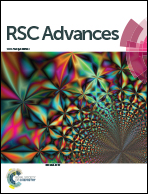Excellent humidity sensor based on ultrathin HKUST-1 nanosheets†
Abstract
The copper-based MOF, HKUST-1 has been applied for humidity sensing owing to hydrophilic ligands and open metal sites which are suitable for sensitively detecting moisture. However, most of the research on the sensor HKUST-1 focuses on the role of the central metal. There are few reports on the morphology–activity relationship of HKUST-1. In this work, we synthesized two kinds of HKUST-1 including octahedral structures and ultrathin nanosheets, and systematically studied the performance of moisture sensing. Compared to HKUST-1 octahedra, HKUST-1 nanosheets showed lower and wider detectable humidity range, achieving a fast response. Starting from the exposed hydrophilic functional groups of HKUST-1 nanosheets, we have revealed that hydrophilic ligands play an important role in improving the adsorption capacity during the adsorption process. In addition, ultra-thin HKUST-1 nanosheets act as an excellent mass transfer medium, accelerating proton transfer and water molecule movement. To further improve the performance of the HKUST-1 humidity sensor, black phosphorus quantum dots (BPQDs) with a high surface reactivity were used to build a composite sensing platform. The excellent proton transfer capability of BPQDs leads to one order of magnitude improvement in the sensitivity of the BPQDs/HKUST-1 systems compared to HKUST-1 only.



 Please wait while we load your content...
Please wait while we load your content...